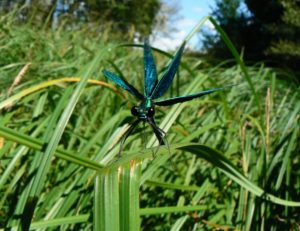
In the animal kingdom colourful traits can be both a blessing and a curse.
A new study from a group of researchers at Uppsala University and Flinders has studied the conspicuous wing coloration of two species of damselflies.
Their results imply that males, but not females, pay a high cost when using colour to communicate with other damselflies, both in terms of predation risk and visibility to prey.
Many animals, such as parrots, tropical fish or butterflies, are colorful. Such colorful displays are favored in sexual selection as they make the animal stand out, and color may therefore enhance mating success. However, color can also be costly because it makes the animal more conspicuous to both predators and prey.
Colorful traits are therefore subject to opposing selection pressures: positive sexual selection by conspecifics (increased mating success) and negative natural selection by predators (higher predation risk) and prey (lowered hunting success).
The paper entitled “The price of looking sexy: Visual ecology of a three level predator-prey system” studied the colorful, and therefore incredibly conspicuous wing coloration of two species of damselflies, which are predated by birds and prey on small flies. The wing coloration is used in color communication between the sexes and between different damselfly species.
Using electrophysiology, researchers from Uppsala in Sweden and Flinders University’s Centre for Neuroscience first determined the color vision of two species of damselflies Calopteryx virgo and C. splendens) and found that they see well in UV as well as in the part of the spectrum that is visible to us humans.
Second, they measured the wing coloration using spectrophotometry and confirmed that males are more colorful than females.
Third, the predation risk was studied in natural populations by quantifying the predated wings from bird feeding stations, and found that more males than females were consumed.
Finally the researchers used the data together with previously known color vision of the bird predator (white wagtail), and the fruit fly prey, to model how visible the wing coloration is in natural environments.
“We found that males are very conspicuous to bird predators, to other damselflies, as well as to prey, while females remain predominantly cryptic (i.e. hard to see against the background),” says Dr Karin Nordström, from Flinders University’s Centre for Neuroscience.
“This implies that males, but not females, pay a high cost when they use color to communicate with other damselflies, both in terms of predation risk and visibility to prey.”
“One of our most surprising findings was that male damselflies are unable to discriminate the wing coloration of perching females,” says David Outomuro, from the Department of Ecology and Genetics, Uppsala University.
“We hypothesise that females use this to reduce male harassment, which is very intense in damselflies.
“Our study demonstrates that by including several levels of interactions in predator-prey systems, we get a more complete understanding of the costs and benefits of being colourful,” he says.
The article, “The price of looking sexy: visual ecology of a three level predator-prey system” by David Outomuro, Linus Söderquist, Frank Johansson and Anders Ödeen (Uppsala University, Sweden) and Karin Nordström (Flinders University, Adelaide), is published by Functional Ecology (British Ecology Society).
For more information contact Karin Nordström on 08 8204 4183 or visit her website here. Dr Nordström’s team is researching the sensory capabilities of insects including biomimetic applications relevant to the development of drones and other technology.

